Bitter gourd
Bitter gourd, also known as bitter melon or Karela in Hindi, is a vegetable with a range of health benefits. Its botanical name is Momordica charantia, and it belongs to the Cucurbitaceae family. This vegetable is highly valued for its medicinal properties, nutritional content, and overall health advantages. Due to its high market demand, bitter gourd cultivation has become quite successful.
Bitter gourd is primarily utilized for making juice and in various culinary applications. It is packed with essential nutrients, including vitamins B1, B2, B3, C, as well as beta-carotene, zinc, iron, phosphorus, potassium, manganese and calcium. The health benefits of bitter gourd include its ability to prevent blood disorders, detoxify the blood and liver, enhance the immune system, and assist in weight management.
Season-
In hilly regions, bitter gourd is typically planted between April and May. In the plains, where the growing season starts earlier, sowing occurs from January to March, particularly in states such as Rajasthan and Bihar. In regions where winter arrives late and persists for a longer period, the planting of bitter gourd is done during February and March. In areas with mild winters, bitter gourd can be sown year-round. In Kerala, where bitter gourd is cultivated intensively, the sowing schedule is as follows: January to February for the summer crop, May to June for the kharif crop, and September for the rabi crop.
States-
Maharashtra, Gujarat, Rajasthan, Punjab, Kerala, Tamil Nadu, Bihar, Karnataka, Uttar Pradesh, Andhra Pradesh, West Bengal, Assam are the major growing states of Bitter gourd.
Bitter gourd is a crop that thrives in warm seasons grown mainly in tropical and sub-tropical regions. The optimal temperature range for its growth and flowering is between 25-30°C. This vegetable can be cultivated in regions with slightly lower temperatures and high rainfall. However, because the seeds have a tough outer coating, germination can be hindered if the temperature drops below 10°C.
Bitter Gourd is adaptable to different soil conditions but performs best in well-drained sandy loam soil that is high in organic content. The optimal soil pH ranges from 6-6.7, but the plant can handle alkaline soils with a pH as high as 8.
- Direct Sowing-
Land Preparation- Plow the soil to a fine tilth and create raised beds or ridges to ensure good drainage.
Seed Treatment: Pre-treat seeds with a fungicide to prevent seed-borne diseases and improve germination rates. Soaking seeds in water for 6-8 hours before sowing can help soften the hard seed coat.
Planting Depth: Sow seeds at a depth of 1-2 cm.
Spacing: Plant seeds in rows with a spacing of 1.5-2 meters between rows and 0.5-1 meter between plants within rows.
Watering: After sowing, water the field adequately to maintain soil moisture for germination.
- Transplanting-
- Nursery Setup: Prepare a nursery bed with well-drained soil or use seed trays filled with a mix of compost and soil.
- Sowing Seeds: Sow seeds in the nursery bed or trays at a depth of 1 cm. Space seeds 5-7 cm apart.
- Germination and Care: Keep the nursery bed in a shaded area and water regularly to maintain soil moisture. Transplant seedlings when they have 2-3 true leaves and are about 4-6 weeks old.
Transplanting Process-
- Field Preparation: Prepare the main field as described for direct sowing.
- Planting: Transplant seedlings into the field, maintaining a spacing of 1.5-2 meters between rows and 0.5-1 meter between plants.
- Watering: Water the plants immediately after transplanting and continue to maintain adequate soil moisture.
Seed Rate-
600-700 gm/acre seed are enough.
Seed Treatment-
- Soak the seeds in water for 6-8 hours before treatment to break dormancy of seeds.
- Treat the seeds with Thiram, Captan, Carbendazim @3gm/kg of seeds, @4gm/kg of seeds, @10gm/kg of seeds respectively.
After sowing, immediate irrigation should be given. During the rainy season, irrigation for the crop may not be required if rainfall is evenly distributed from July to September. Typically, ridges are watered one or two days before sowing the seeds. After planting, a light irrigation is usually provided 4 to 5 days later.
Fertilizer requirement (kg/acre)
| Urea | SSP | MOP |
| 30 | 125 | 35 |
Nutrient requirement (kg/acre)
| Nitrogen | Phosphorus | Potassium |
| 13 | 20 | 20 |
Before sowing, apply 10-15 tonnes of Farmyard Manure to the field, ideally 10-15 days in advance. Along with the FYM, provide a fertilizer regimen that includes 13 kg of nitrogen per acre, typically applied as 30 kg of urea per acre, 20 kg of phosphorus per acre using 125 kg of Single Super Phosphate per acre, and 20 kg of potassium per acre with 35 kg of Muriate of Potash per acre.
Apply the full amount of phosphorus and potassium, and one-third of the nitrogen, before sowing the seeds. The remaining two-thirds of the nitrogen should be added about one month after sowing.
To manage weed growth, the crop requires 2-3 weeding sessions. Typically, the first weeding is carried out 30 days after planting. Following this, additional weeding should be performed at monthly intervals to maintain a weed-free environment.
Earthing up is done during rainy season. Mulching can be a better option to overcome weed population. Use Plastic or organic mulch according to availability.
Spray Pendimethalin 30 EC as pre-emergence herbicide 200-300ml/acre. For Post-emergence herbicide- Glyphosate @600-700ml/acre is effective.
- Nitrogen-
Symptoms-
Bittergourd plants exhibit stunted vegetative growth and limited fruit production. They appear pale and slender, with new leaves small yet retaining their green color. However, the oldest leaves turn yellow and eventually die off. This yellowing progress upwards along the shoots to affect younger leaves as well.
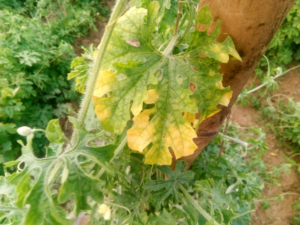
Management-
Foliar spray of urea @2% fortnightly.
- Potassium-
Symptoms-
Symptoms such as yellowing and browning of older leaves. Intially, symptoms appear at the leaf margins and spread inward between the veins. Areas around the major veins remain green until the deficiency worsens. As the condition progress, affected areas develop a brown scorched appearance, eventually causing the leaf to become dry and papery.

Management-
Foliar application of KCl @1% at weekly interval.
- Calcium-
Symptoms-
Newly emerging leaf shows signs of scorching & distortion. These leaves may appear curled downwards because their margins failed to expand fully. However, mature and older leaves remain unaffected by these symptoms.
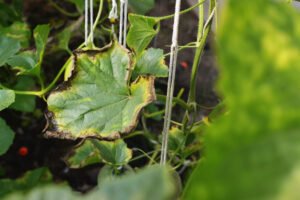
Management-
For soil lacking calcium symptoms, Gypsum should be applied. Alternatively, Calcium sulfate can be applied via foliar spray as 2% solution in water.
- Magnesium-
Symptoms-
Symptoms like yellowing of older leaves, as the deficiency progress yellow areas develop a light tan brown.
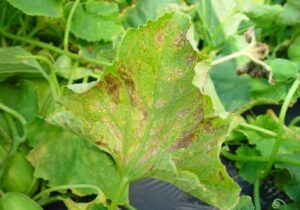
Management-
Incorporate Magnetite @300kg/acre or dolomite @800kg/acre. Foliar application of MgSO4@2kg/100L of water.
- Boron-
Symptoms-
Older leaves exhibit a distinct broad yellow border along their margins. Young fruits are susceptible to premature death or abortion. Plant growth is retarded and leaves develop yellow streaks that later develops into rough, corky patches known as scurfing on the fruit’s skin.
Management-
Foliar application of Borax @2% at fortnightly interval.
- Iron-
Symptoms-
Iron deficiency in plants results in the newest leaves exhibiting a uniform pale green chlorosis, while older leaves retain their dark green color. Initially, the veins of the affected leaves remain green and leaves may eventually develop a burnt appearance, particularly when exposed to intense sunlight.
Management-
Foliar application of FeSO4 @0.5%.
- Manganese-
Symptoms-
Manganese deficiency in plants causes the veins of middle to upper leaves remain green. Contrasting with the mottled appearance of the leaf blade, which ranges from pale green to yellow.
Management-
Application of MnSO4 @100gm/100L of water.
- Air Pollution-
Symptoms-
- Leaf Discoloration
- Necrotic Patches
- Leaf Burn
- Stunted Growth
- Abnormal flowering & Fruit development
Management-
- Foliar spray of Calcium Nitrate or Magnesium Sulfate.
- Use antioxidants solutions like ascorbic acid (Vitamin C) or seaweed extracts. These can help mitigate oxidative stress caused by pollutants and enhance plant resilience.
- Apply Gypsum to the soil to improve soil structure and mitigate the effects of pollutants like sulfur dioxide.
- Apply organic mulch around the base of plants to conserve soil moisture and reduce stress on plants caused by pollutants.
- Rotate crops to minimize continuous exposure of bitter gourd to pollutants in the soil and air.
- Atrazine Pesticide Injury-
Symptoms-
Atrazine, a strong herbicide used extensively in grain farming, can leave behind residues that persist for several years. This residual effect can limit the planting of broadleaf crops in the future. Crops affected by Atrazine may show signs of stunted growth and severe leaf damage, resulting in diminished plant vitality and lower yields.

Management-
Maintain detailed records of your cropping rotations and avoid planting sensitive crops in fields previously treated with persistent chemicals.
- Chilling/Frost Injury-
Chilling Injury in Bitter Gourd occurs when plants are exposed to low temperature. This condition can lead to several symptoms and adverse effects to plants:
Symptoms-
- Yellowing and water soaked appearance.
- Discoloration of fruits.
- Fruits may become soft, mushy and prone to decay.
- Leads to reduced growth and development.
- Abnormal ripening.
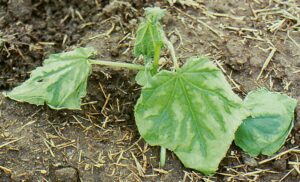
Management-
- Prune affected plant areas
- Ensure plants receive adequate water to alleviate stress. However, avoid overwatering, as waterlogged soils can cause root damage.
- Apply balanced fertilizer.
- Apply mulch around plants to help regulate soil temperature and moisture levels, which can aid in reducing stress on recovering plants.
- Excess Soil Moisture-
Symptoms-
Excessive water can be as harmful to plants as insufficient water, particularly if the flooding lasts more than 2 to 3 days. Roots need plenty of oxygen to thrive, but waterlogged soils quickly become deficient in oxygen. This can lead to stunted growth and nutritional deficiencies in plants due to poor root absorption. Additionally, waterlogged conditions increase the risk of root diseases.
Management-
To promote proper drainage, level the fields and plant on raised beds. Avoid using fields with poor drainage capabilities.
- Salt Injury-
Symptoms-
High salinity from poor water quality or incorrect fertility practices can stunt plant growth and, in severe instances, lead to plant death. Plants exposed to elevated salt levels often show initial dark green coloration, but quickly develop yellowing at the edges and necrosis in older leaves.

Management-
For crops grown in greenhouses and containers, it’s essential to carefully regulate fertilization and watering practices. Ensuring that container plants are watered to the point of runoff will help avoid salt buildup.
- Fruit Fly-
Stage of attack- Early Seedling Stage
Symptoms-
- Secretion of resinous fluid from affected plants
- Deformation and irregular formation of bitter gourd fruits.
- Infected fruits are prone to premature dropping from the veins, rendering them unsuitable for consumption.

Management-
- Collect and remove all the infected plants from the field and maintain field sanitation.
- Apply Carbaryl 50%WP @3gm/L of water or Malathion 30 EC @1ml/L of water.
- After harvest, it is beneficial to plough and overturn the soil to expose pupae to sunlight and air.
- Stem Borer-
Stage of attack- Vegetative and Early Seedling Stage
Symptoms-
The larvae of stem borer tunnels into the stems, where they feed on the inner tissues, causing damage that can weaken the plant, affects its growth and sometimes leads to wilting or even death of the plant if the infestation is severe.
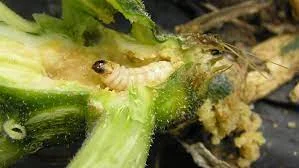
Management-
- Collect and destroy the affected plants from the field and maintain field sanitation.
- Avoid planting cucurbitaces plants in the same location for many years to reduce pest build up.
- Encourage natural enemies such as parasitic wasp that prey on stem borer larvae. Planting nectar rich flowers can attract insect.
- Planting trap crops that attract stem borer away from the main crop can reduce damage to bitter gourd plants.
- Application of Carbaryl @500gm/150L of water.
- Red Pumpkin Beetle-
Stage of attack- Early Seedling Stage
Symptoms-
- The adult beetles and larvae feeds voraciously on the leaves of bitter gourd plants. They create irregular holes and skeletonize the leaves, leaving behind a lace-like appearance.
- Heavy infestations of red pumpkin beetle can lead to severe defoliation of bitter gourd plants.
- In addition to leaves, beetles also feed on tender stems, causing damage and weakening plant structure.
- They also damage young fruits. They create shallow pits or scars on the surface, which can lead to secondary infections or affect fruit quality.
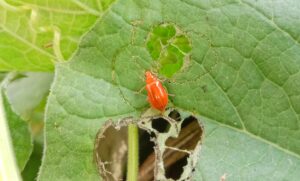
Management-
- Ploughing fields immediately after harvest disrupts the hibernation of adult red pumpkin beetles, aiding their elimination.
- Removing adult beetles manually helps reduce their numbers and minimize their damage to bitter gourd plants.
- Application of insecticides like Malathion 50 EC @7ml/L of water, Dimethoate 30 EC @ 2.5ml/L of water.
- Aphids-
Stage of attack- Seedling, Vegetative and Flowering
Symptoms-
- Small, pear shaped bodies insect can be seen on the leaves and stems of the plant.
- Aphids feeds on tender shoots and under surface of leaves by sucking the leaf cap causing curling and crinkling of the leaves.
- Black soot mould development due to honeydew secretion on the leaves.
- Leads to stunted growth and reduce the photosynthetic activity of the plant.
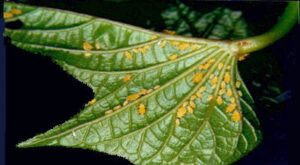
Management-
- Set up yellow sticky trap @4-6/acre
- Application of following insecticide-
Azadirachtin 5%EC @0.5ml/water
Profenofos 40% + Cypermethrin 4% EC @2ml/L of water
- Stem Gall fly-
Stage of attack- Early stages of growth
Symptoms-
- Swelling and galls form on the stems and sometime on the leaves where the larvae feeds.
- Plants show stunted growth.
- Leaves may turn yellow and wilt due to the damage caused by the larvae feeding inside the plant tissue.
- In severe infestation, stems may crack or split open at the sites of gall formation.
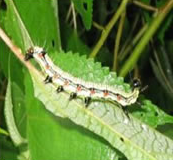
Management-
- Spray any of the following insecticides-
Malathion 50 EC @200-300ml/acre
Dimethoate 30 EC @1.5ml/L of water
- Snake Gourd Semilooper-
Stage of attack- Seedling stage
Symptoms-
The caterpillar cuts the edges of leaves lamina, fold it over the leaf and feeds from within the leaf roll. Symptoms include irregular holes or chewed edges on the leaves and in severe infestation defoliation also occur.

Management-
- Spray any of the following insecticides-
Malathion 50 EC @200-300ml/acre
Dimethoate 30 EC @1.5ml/L of water
- Pumpkin Caterpillar-
Stage of attack- Vegetative and Reproductive Stage
Symptoms-
- During its early stages, the young larva scrapes away the chlorophyll content from the leaves, leaving behind thin translucent patches.
- The Caterpillar folds and web the leaves, creating sheltered feeding areas where it continues to consume leaf tissue.
- It consumes flowers, potentially reducing the plants ability to produce fruits.
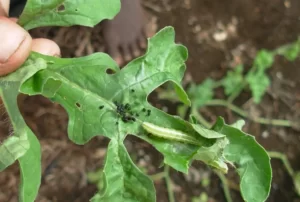
Management-
- Collect and destroy the infected plants from the field and maintain field sanitation.
- Spray any of the following insecticides-
Malathion 50 EC @200-300ml/acre
Dimethoate 30 EC @1.5ml/L of water
- Leaf Miner-
Stage of attack- Vegetative and Early Reproductive Stage
Symptoms-
- Presence of Serpentine and winding mines on the leaves. The mines appear as whitish or translucent trails that can vary in shape and size depending on the species of the leaf mines.
- As the larvae feed inside the leaves, they disrupt the normal structure and function of leaf tissue. This can lead to visible damage such as discolored patches, necrotic areas or even holes in severe cases.
- Result in reduced plant vigor, slowed growth, and overall decreased yield potential.
- Infested plants may show sign of stress, such as wilting and yellowing of leaves, particularly if the infestation is severe or prolonged.
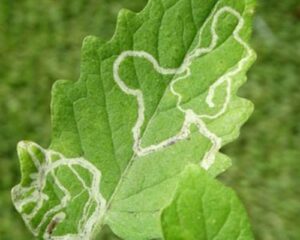
Management-
- Set up yellow sticky trap to attract leaf miners.
- Apply Cypermethrin 4% SC @400ml/acre
- Powdery Mildew-
Causal Organism- Erysiphe spp.
Symptoms-
- White powdery spots can form on both the surfaces and expand into large blotches.
- Fruits ripen prematurely.
- Infected plants produce fewer and small fruits.
- Pale yellow spots can be seen on leaves.

Favorable Conditions-
Warm, Humid conditions and temperature between 20-28oC favors the growth of this disease.
Management-
- Plant disease resistant varieties.
- Apply wettable sulphur @0.2%
- Collect and destroy the affected plants and maintain field sanitation.
- Apply Propiconazole 25%SC @2ml/acre or Copper sulfate @2gm/L of water.
- Fusarium Wilt-
Causal Organism- Fusarium oxysporum
Symptoms-
- The first symptom is the clearing of the veinlets and chlorosis of the leaves.
- The younger leaves may die in succession and the entire leaves may wilt and die in course of few days.
- In severe infestation, petiole and leaves may wilt and drop off from the plant.
- At the later stages, browning of vascular system occurs.
Favorable Conditions-
Temperature between 25-27oC , warm moist soil favors the growth of this disease.
Management-
- Rotate crops with non-host crops like cereals, legumes to reduce soil inoculum levels.
- Collect and destroy the infected plants from the field and maintain field sanitation.
- Apply Carbendazim @300gm/acre.
- Downy Mildew-
Causal Organism- Peronospora parasitica
Symptoms-
- Yellow to pale green spots form on the upper and lower surface of leaves ,later these spots turn to brown in color.
- Entire leaves dries up quickly.
- Spots turn to necrotic as the disease progresses.
- Infested plants die and dries
- Fruits produce may not mature and have poor taste.

Favorable Conditions-
Mild temperature and wet weather favors the growth of this disease.
Management-
- Plant disease resistant varieties.
- Application of Mancozeb @2gm/L of water
- Bitter Gourd Mosaic-
Casual Organism- Begomovirus bitter Gourd Yellow Mosaic Virus
Symptoms-
This viral disease primarily affects the leaves, especially those on secondary branches at the apical end of the plant. Infected leaves display small, irregular yellowish spots. Some leaves exhibit vein clearing in one or two of their lobes, while severely affected plants show reduced leaf size and elongation, with one or two lobes often suppressed. Young leaves may become completely distorted and malformed, significantly decreasing in size.

Favorable Conditions-
Intermittent rainfall, moderate weather with a temperature of 22-28oC favors the growth of this virus.
Management-
Foliar application of Bavistin @1gm/L of water can control this disease.
- Anthracnose –
Causal Organism- Colletotrichum orbiculare
Symptoms-
This disease initially manifests as small, multi-colored, circular lesions on the older leaves, although in some cases, these lesions can be more angular, As the condition progresses, these spots expand and coalesce, darkening over time. This results in the progressive loss of leaves and, in severe cases, the death of the plant due to defoliation or stem girdling. Affected fruit will exhibit sunken, round, water-soaked lesions.

Favorable Conditions-
Warm and wet weather, temperature between 25-28oC favors the growth of this disease.
Management-
Application of Copper Hydroxide 53.8%DF @2gm/L of water can control this disease to some extent.
- Angular Leaf Spot-
Causal Organism- Pseudomonas syringue
Symptoms-
- The disease begins with the formation of tiny, angular spots on the leaves, displaying brown or straw hues with a distinct yellow border. As the spots dry up, they drop out, resulting in uneven holes throughout the foliage.
- Leaves irregular spots on the leaves.
- Water-soaked tan colored spots can be seen on the fruits.
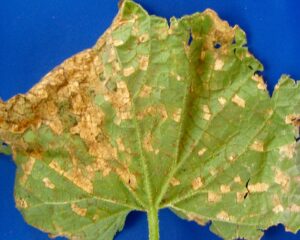
Favorable Conditions-
Warm humid weather, temperature between 24-29oC, High relative humidity above 80% favors the growth of this disease.
Management-
- Use drip irrigation instead of overhead irrigation to avoid excessive soil moisture
- Remove and destroy infected plants from the field
- Application of Copper Oxychloride 50%WP @2gm/L of water
- Cercospora Leaf Spot-
Casual Organism- Cercospora citrullina
Symptoms-
- Small, circular irregular spots can be seen on the leaves.
- The spots on the leaves typically have a central area that is brown or gray, surrounded by a distinct yellow or reddish-brown edge.
- Infected leaves often begin to exhibit yellow or brown discoloration around the spots, eventually leading to the leaves drying out and falling off.
- Causes premature defoliation of leaves.

Favorable Conditions-
Spores of Cercospora leaf spot are air borne, infection is favored by temperature between 26-32oC.
Management-
Application of Copper Oxychloride 50%WP @2gm/L of water can control this disease.
Harvesting-
Bitter gourd crops typically require 55 to 60 days from the time of sowing seeds to the initial harvest. Subsequent harvests should be carried out every 2 to 3 days, as the fruits mature quickly and can turn red if not picked promptly. The ideal harvesting time can vary depending on the specific variety of bitter gourd. Generally, fruits should be collected while they are still tender and green to prevent them from turning yellow or orange during transport. It is best to harvest in the morning and keep the fruits in a shaded area after picking.
Yield-
Yield depends on different factors such as cultivation technique, soil conditions, variety used, but the average yield is about 15-20 tonn/acre.